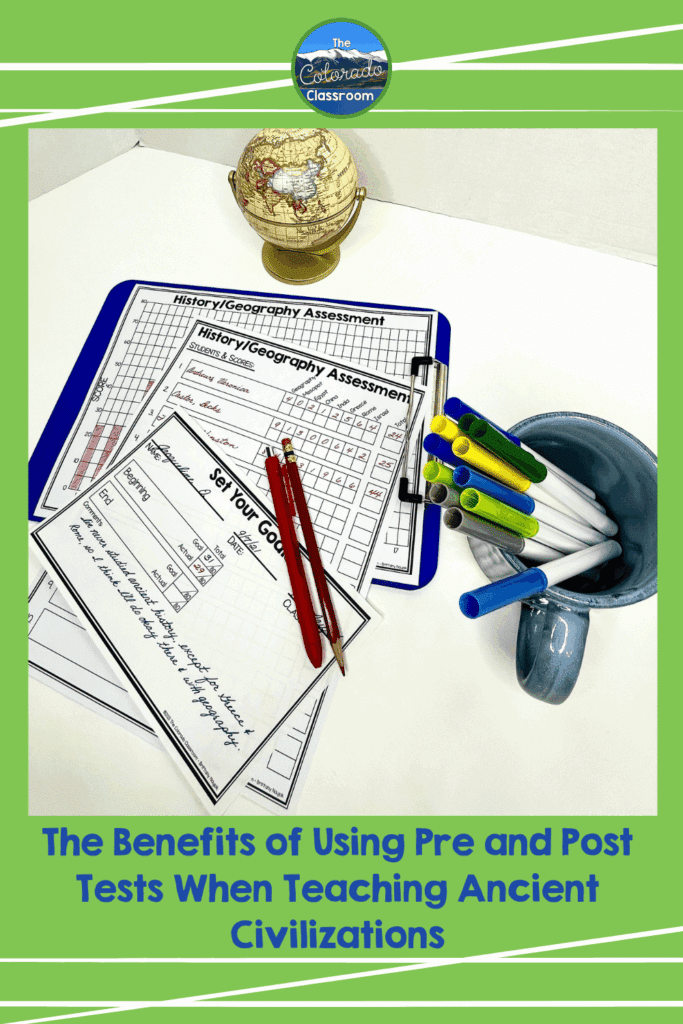The Benefits of Using Pre and Post Tests When Teaching Ancient Civilizations
Teaching ancient civilizations in middle school is such an exciting journey. You get to transport your students across time. They get to walk through the streets of ancient Rome, explore the pyramids of Egypt, and decode cuneiform from Mesopotamia. Before the adventure begins, it helps to know where your students are starting from and where they’re headed. That’s where pre and post tests come in. These simple assessments can make a big difference in how you plan, teach, and reflect on your unit. Today, we’re diving into exactly why pre and post tests are such a powerful tool when teaching ancient civilizations.
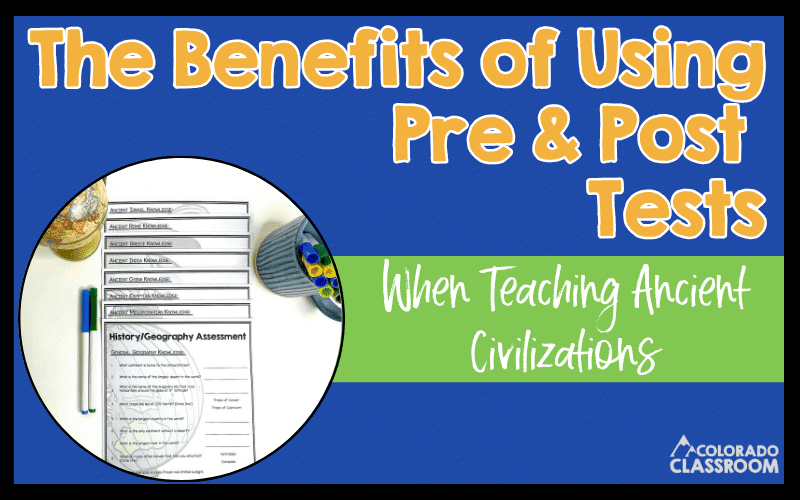
Why Pre and Post Tests Matter in Ancient Civilizations
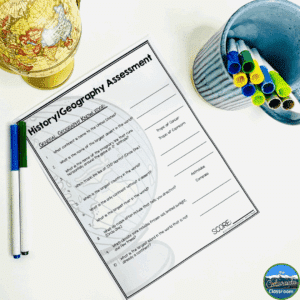
Let’s be real, teaching middle schoolers about ancient civilizations is no small feat. You’re not just covering dates and dusty ruins. You’re unpacking how early societies shaped the world we live in today. That’s where pre and post tests come in. These assessments give you a solid foundation for understanding what your students already know and what they’ve picked up along the way.
In a subject like social studies, where our students often come in with wildly different background knowledge, pre and post tests give you a roadmap. Are they already familiar with Egyptian pyramids? Do they understand how governments functioned in ancient Greece? You’ll find out quickly, and you can adjust your teaching to match.
So, whether you’re launching into Mesopotamia or diving into the dynasties of China, these assessments can guide your pacing, highlight what’s working, and show off all that incredible growth your students are making.
What Are Pre and Post Tests in Social Studies?
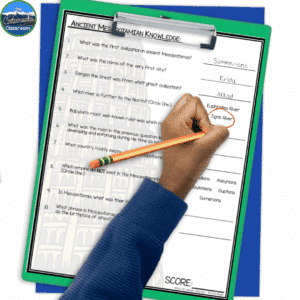
Let’s break it down. A pre-test is what you give at the start of your ancient civilizations unit. It helps you see what knowledge students are bringing with them before you begin your instruction. A post-test comes at the end and shows exactly what they’ve learned.
These aren’t just basic quizzes. A good pre and post test digs into content knowledge, vocabulary, and even higher-order thinking skills like comparing societies or analyzing cause and effect. With ancient civilizations, you might assess understanding of things like trade routes, religion, daily life, and government systems.
In my Ancient History Pre and Post Assessment, you’ll find both print and digital options for easy access, no matter how your classroom is set up. The questions touch on key civilizations such as Egypt, Greece, Rome, Mesopotamia, China, and more, offering a broad look at what your students need to know.
Why We Use Pre and Post Tests in Ancient Civilizations

As we know, our middle schoolers can surprise us. Some come in with years of history knowledge; others are hearing about ancient civilizations for the very first time. That’s exactly why pre and post tests are so helpful. They give you data. Not just data for data’s sake. This is the kind of information that drives instruction.
The pre-test helps you see where you need to spend more time. Maybe students know quite a bit about ancient Egypt, but their knowledge of the Indus Valley is spotty. That insight helps you prioritize, focus discussions, and group students strategically.
When the post test rolls around, it’s not just about assigning a grade. It’s about tracking growth. You get to show your students how far they’ve come. That builds confidence and accountability. Plus, this is fantastic information to share with families, colleagues, or admin when it’s time to reflect on student learning and curriculum goals.
The Benefits of Pre and Post Tests for Teaching Ancient Civilizations

One of the biggest benefits of using pre and post tests is that it allows both you and your students to reflect on growth. With ancient civilizations covering such a wide range of content, from timelines to religion to technological innovations, it’s helpful to have benchmarks along the way.
Your students often don’t realize how much they’ve learned until it’s laid out for them. The difference between their pre and post tests creates a visual and measurable reminder of how their knowledge has expanded. They may act cool, but middle schoolers love to see their own improvement, too!
It also helps you make teaching more intentional. You’re not just checking off topics. You’re responding to actual gaps and strengths in your classroom. That means less guesswork and more impact.
Pre and Post Tests Build Confidence and Accountability

There’s something powerful about your students seeing their own growth. With pre and post tests, you can turn that power into motivation. Your students who might have felt unsure about ancient civilizations at the beginning will finish the unit feeling like experts.
That confidence matters. It helps your students engage more in class discussions, take pride in their projects, and even look forward to history lessons. Since they’ve had a chance to reflect on what they’ve learned, they start to understand how learning works. It builds over time.
Accountability plays a big role here, too. By setting learning goals at the start, your students are more likely to stay focused. When the post-test comes around, they’re not surprised but prepared.
Track Student Progress Over Time with Pre and Post Tests
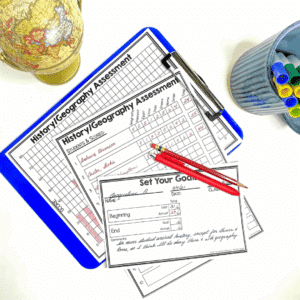
Using pre and post tests consistently across your ancient civilizations unit doesn’t just give you a snapshot of learning. It gives you a timeline. This is especially helpful if you’re looping with your students or looking to build long-term skills in social studies.
The data collected can help you plan future units or tailor review activities. You’ll notice patterns, like which topics tend to need more review (looking at you, Ancient Mesopotamia!) and where your students tend to thrive (hello, Roman architecture!).
Additionally, these assessments make grading and facilitating communication smoother. You have clear, documented evidence of learning that you can share during parent conferences or PLCs. That kind of record-keeping is invaluable, especially in a standards-based grading system.
How to Use This Pre and Post Test Resource Effectively
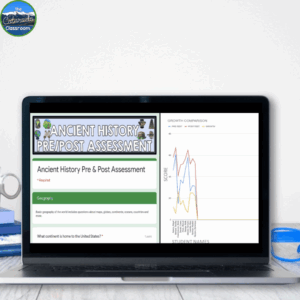
My Ancient History Pre and Post assessment resource will work for you and not add to your plate. With both paper and digital versions, it’s easy to use no matter your classroom format. The digital versions are editable in Google Slides. There are Google Sheets tracking forms that automatically calculate student growth and display it in bar graphs. Talk about saving time!
Plus there are plenty of options to choose from! There are 8 concepts, each covered with 10 questions, and offered in 3 different versions. You’ll find clear directions for administering the tests and a layout that’s student-friendly. Each test includes a mix of multiple choice and short answer questions. There’s even a goal-setting form you can use with your students so they take ownership of their learning from the start.
I also made sure to include tracking sheets. You’ll be able to see student progress by topic, allowing you to celebrate strengths or revisit areas that didn’t quite stick. That kind of real-time insight helps you shift your instruction mid-unit if needed, keeping learning on track.
Grab Complete Ancient Civilizations Units
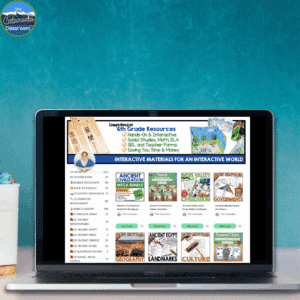
Now that you’re set up with meaningful pre and post tests, it’s time to dive into the heart of your ancient civilizations units. If you’re looking for ready-to-go resources that will keep your students engaged and make your planning easier, I’ve got you covered!
In my TPT shop, you’ll find complete units for ancient civilizations that are designed to flow right from the pre-test through all the core content, activities, and projects. They will lead perfectly to the post test at the end. These units include everything from interactive notebooks to hands-on tasks and creative assessments. You’ll find engaging materials to bring these civilizations to life while reinforcing learning all the way through.
Pre and Post Tests Are the Perfect Starting Point
You don’t need to reinvent the wheel each year. This pre and post test resource is ready to go, saving you hours of prep time while still giving your students a high-quality, standards-aligned experience. Whether you’re diving into ancient civilizations for the first time or refreshing your approach, this is the kind of tool that makes your life easier. By starting with a solid assessment, you’re setting yourself and your students up for success. Everything from pacing to differentiation becomes clearer when you know exactly where your students are starting.
Save for Later
Want to come back to these ideas when you’re planning your next unit? Be sure to pin or bookmark this post so you have it handy when you’re gearing up to teach ancient civilizations!
